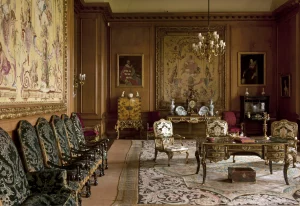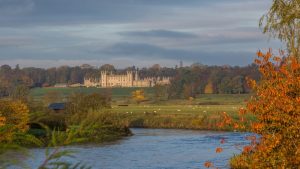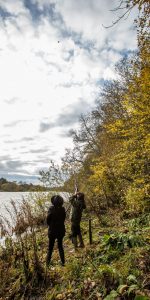DRIVEN SHOOTING / PHEASANTS / SCOTLAND / KELSO / FLOORS CASTLE
DRIVEN PHEASANT SHOOTING IN THE SCOTTISH BORDERSThrilling pheasant shooting on the banks of the river Tweed
LOCATION
Floors Castle, Scotland, The Borders, Kelso
TRIP DURATION
1 Day
GROUP SIZE
Up to 8 people
FOOD & DRINK
Elevenses, Lunch and Some Drinks
NEAREST AIRPORT
Edinburgh
QUARRY
Pheasants
SEASON
October 1st to February 1st
BAG SIZE
150 to 300
SHOOTING STYLE
GUNS AND AMMUNITION
Please Enquire
From £77 per bird
Customise Your Trip
From £77 per bird
Hosted at Floors Castle
Parkland shooting in the borders
One of the finest sporting estates in all of Scotland
INFO
Blank
Floors Castle
The present-day structure of the house reflects the culmination of two significant phases of construction. The initial phase, spanning from 1721 to 1726 under the guidance of esteemed architect William Adam, was commissioned by the 1st Duke. It is believed that the original design, perhaps inspired by Sir John Vanbrugh, the mastermind behind Castle Howard in Yorkshire and Blenheim Palace in Oxfordshire, influenced the project. Although the first Duke and Vanbrugh were acquaintances, it was Adam who ultimately brought the vision to life with his remarkable craftsmanship.
Initially, Broxmouth Park, situated near Dunbar, served as the principal familial abode. However, Floors House gained prominence after 1730 when the 1st Duke’s mother decided to permanently relocate there. Although the Duke himself predominantly resided in the southern regions of England to remain close to Parliament, he always held his time spent “in the country” in high regard.
This magnificent Georgian house was meticulously constructed upon a natural terrace, offering an exquisite vantage point overlooking the Tweed River. Its orientation provided a direct southern view of the commanding remnants of Roxburgh Castle, perched atop its imposing mound and reigning over the local landscape. Floors House remains clearly discernible from the primary river crossing into the town of Kelso, its distinctive sandstone facade conspicuously standing out, even on the dreariest of days. The opulence of the house and its idyllic setting prompted the venerable Sir Walter Scott, the internationally renowned author and frequenter of distinguished estates in the beloved Scottish Borders, to declare Floors House as “a realm befitting Oberon and Titania’s dwelling.”
During the tenure of the 6th Duke, spanning from 1836 to 1847, the eminent Edinburgh architect William Playfair undertook a series of renovations to harmonize the original structure with the surrounding landscaped park. Playfair masterfully introduced an enchanting silhouette, reminiscent of a tale from folklore, while extending the house and executing interior redevelopments. He also constructed a splendid coach port, offering sheltered respite to esteemed visitors from the elements. The outcome of these endeavors is the embodiment of one of Scotland’s most iconic buildings. In 1838, Playfair himself penned these words of contentment: “The Duke and Duchess extend their warmest regards and are thoroughly delighted with the alterations made to their residence, vowing to implement all my recommendations both inside and out.”
Following the matrimonial union of the 8th Duke with the affluent American heiress of real estate, Mary Goelet, in 1903, the castle underwent yet another metamorphosis. The new lady of the house spared no expense in lavishly remodeling the Victorian interiors, adorning them with an exquisite array of artwork, tapestries, porcelain, and furniture. Many of the state rooms were painstakingly reimagined to accommodate these splendid additions. The rooms that are now open to the public proudly stand as a testament to the sweeping transformations undertaken during this remarkable period.
The Estate
The Estate operates as a contemporary enterprise, incorporating diverse sources of income and investments. Spanning an expansive area of approximately 52,000 acres (21,000 hectares), it encompasses a range of picturesque Borders landscapes, stretching from the majestic Cheviots to the rolling Lammermuirs, and encompassing the fertile lands of the Tweed valley.
The diverse topography of the Estate gives rise to a wide range of farming practices, leading to a rich variety of agricultural produce. The in-house farming operations primarily focus on rearing sheep and cattle, with the notable distinction of producing sought-after Cheviot lamb, unique to the Borders region.
In addition to livestock farming, the Estate engages in arable cultivation, with major crops including wheat and oilseed rape. The cultivation of malting barley, potatoes, and various vegetables also contributes to the agricultural endeavors. Beyond farming, the Estate undertakes various other activities such as forestry, green energy initiatives, conservation efforts, property management, and the provision of sporting pursuits.
A Day In The Field
The Estate team will warmly welcome you at Floors Castle at approximately 8:45 am, where you will receive a comprehensive morning briefing. Shortly after 9 am, we will embark on our first two shooting drives, followed by a delightful assortment of elevenses, skillfully prepared by the private chef of the Duke of Roxburghe. A personal favorite among the offerings is the pheasant goujons accompanied by a delectable garlic aioli. Elevenses will be served in the field or at a charming fishing hut overlooking a picturesque stretch of the river Tweed.
We will then proceed with two additional drives in the late morning, before making our way to the Courtyard at Floors Castle to indulge in a delightful lunch. After savoring a seasonal feast that will warm both body and spirit, the guns will return to the field for a final drive to conclude the day’s shooting activities (or perhaps two drives if the bag and daylight hours allow!). The drives at Floors Castle offer a captivating variety, ranging from the gently undulating parkland drives to truly spectacular experiences along the banks of the Tweed. Pheasants will be driven from elevated flushing points situated on the steep riverbank, while the guns take their positions below. The boatmen and their skilled dogs will diligently work to retrieve your harvested game.
What's Included
Included |
|
Required |
|
Optional Extras |
|
Getting There
Available Dates
Blank
200 Birds - December 4th
300 Birds - December 27th
200 Birds - January 5th
150 Birds - January 8th
Customise Your Trip
From £77 per bird
FAQ’s
Blank
Can I come on my own or with friends?
Yes, bookings are completely customisable. Just mention your requirements when you enquire.
Can I bring a non-shooting guest?
Yes, non-shooting guests are welcome at a supplement.
Do I need a shotgun licence and insurance?
Each person shooting will need insurance, we will organise local permits for international visitors
We can organise insurance through our partnership with CCC3 if you don’t already have it, simply mention that you require insurance when you enquire.
Do you offer upgraded hospitality?
Yes, private bookings are completely customisable. Just mention your requirements when you enquire.
Pheasant Shooting - Floors Castle - Scotland
Customise Your Trip
From £1800
Fincal La Caminera
Widiane Chasse
Frochas
Despenadero Alto
Chateau Matra
Las Loberuelas



